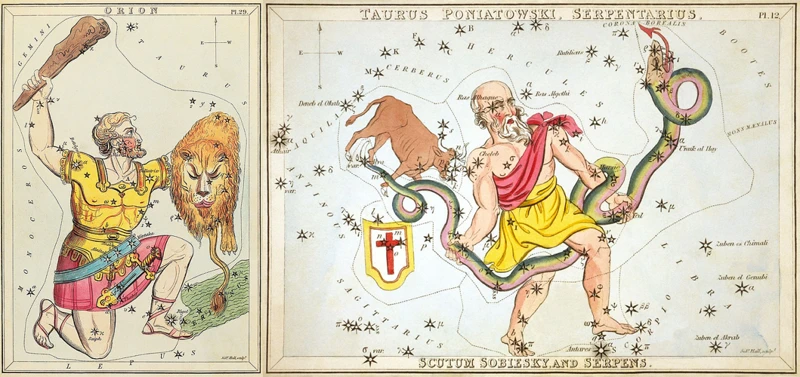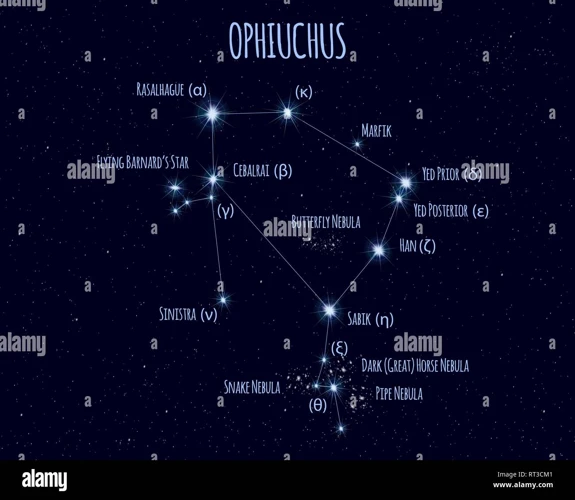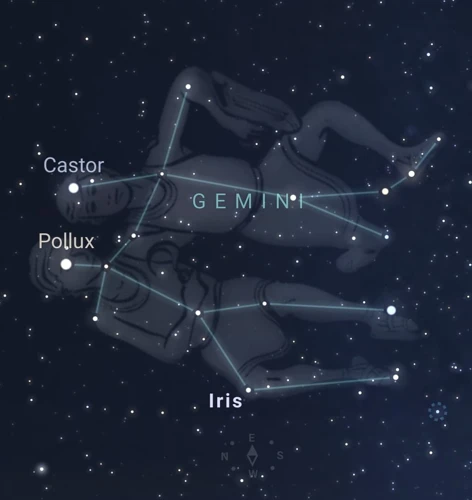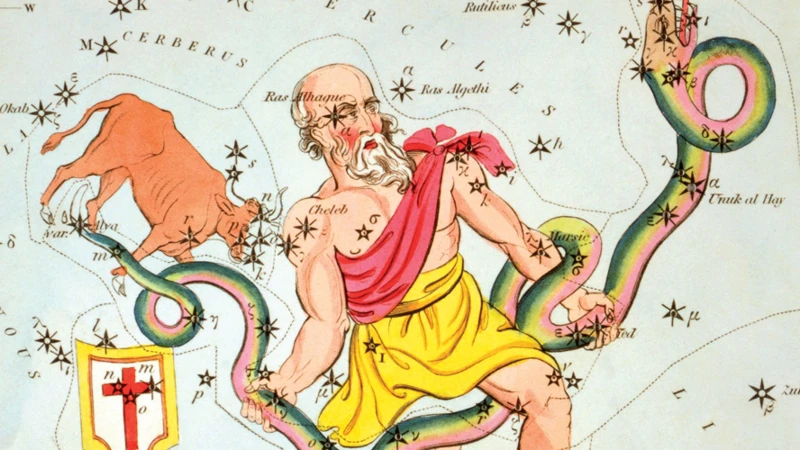As the night sky envelops us in its bewitching veil, there exists a constellation that never fails to capture our imagination – the celestial twins known as Gemini. Residing in the northern hemisphere, Gemini is a fascinating constellation steeped in mythology and dotted with shimmering stars that have intrigued stargazers for centuries. In this article, we will delve into the mesmerizing world of Gemini, uncovering its mythological origins, exploring its prominent stars and features, discovering how to locate it in the night sky, offering tips for observation, and highlighting its cultural significance. So, prepare to be enthralled as we embark on a cosmic journey to explore the enigmatic wonders of Gemini.
Contents
- The Mythology Behind Gemini
- Stars and Features of the Gemini Constellation
- How to Locate Gemini in the Night Sky
- Tips for Observing Gemini
- Significance and Cultural References
- Conclusion
-
Frequently Asked Questions
- 1. What does the Gemini constellation represent?
- 2. Can I see the Gemini constellation with the naked eye?
- 3. How do I locate the Gemini constellation in the night sky?
- 4. What are some notable features of the Gemini constellation?
- 5. When is the best time to observe the Gemini constellation?
- 6. How can I incorporate the Gemini constellation into my astrology practice?
- 7. Are there any cultural references to the Gemini constellation?
- 8. What is the significance of the Gemini constellation in astronomy?
- 9. Can I see any meteor showers associated with the Gemini constellation?
- 10. How many stars are there in the Gemini constellation?
- References
-
Frequently Asked Questions
- 1. Can I see the Gemini constellation with the naked eye?
- 2. What is the best time of year to observe the Gemini constellation?
- 3. Are there any notable deep-sky objects within the Gemini constellation?
- 4. How do I locate the Gemini constellation in the night sky?
- 5. Can I observe the Gemini constellation from both hemispheres?
- 6. What is the mythology behind the Gemini constellation?
- 7. Which are the brightest stars in the Gemini constellation?
- 8. What equipment do I need to observe the Gemini constellation?
- 9. Are there any interesting cultural references to the Gemini constellation?
- 10. Is there any scientific research associated with the Gemini constellation?
- References
- Read More
The Mythology Behind Gemini

In , we delve into the captivating tales that surround this constellation. Gemini is commonly associated with the story of Castor and Pollux, the Gemini twins of Greek mythology. According to the myth, Castor and Pollux were born to Leda, the queen of Sparta. Castor was mortal, while Pollux was immortal as his father was the mighty Zeus. The twins were inseparable, and their bond strengthened as they embarked on extraordinary adventures together. Castor, known for his remarkable horsemanship, and Pollux, famed for his prowess in boxing, were both revered for their bravery and heroism. The story of the Gemini twins also intertwines with the story of the Argonauts, as these brothers joined the quest for the Golden Fleece. In the end, when Castor met his demise in battle, the grieving Pollux asked Zeus to grant him immortality so that they could remain together forever. Zeus honored his request, and Castor and Pollux were immortalized in the night sky as the Gemini constellation. This mythological tale adds an air of wonder and intrigue to the celestial twins, making them an irresistible subject for sky gazers and mythology enthusiasts alike.
Link: ascendant sign
Stars and Features of the Gemini Constellation

Gemini, the celestial twins, is adorned with a remarkable collection of stars and captivating features. One of the most prominent stars in the constellation is Pollux, a giant orange star located about 34 light-years away from Earth. Its golden hue adds warmth to the night sky. Another brilliant star, Castor, is actually a complex multiple-star system consisting of six individual stars orbiting one another. These stars are so close together that they cannot be resolved by the naked eye, but they create a stunning celestial spectacle for observers. Additionally, Gemini is home to the open star cluster M35, located at a distance of approximately 2,800 light-years. This cluster contains over 120 stars, forming a dazzling cluster that sparkles like a jewel in the night sky. The stars and features of Gemini contribute to its allure and make it a fascinating destination for stargazers and astronomy enthusiasts.
Link: Aries
Gemini’s Brightest Stars
Gemini, the radiant constellation, boasts several brilliant stars that illuminate the night sky. One of the most notable stars in Gemini is Castor, named after one of the mythological twins. Castor is a multiple star system composed of six individual stars, making it a true stellar gem. Another prominent star in Gemini is Pollux, named after the other celestial twin. Pollux shines with a golden hue and is significantly brighter than Castor. These two stars, Castor and Pollux, are often referred to as the “Twin Stars,” representing the twins from Greek mythology. With their luminosity and close proximity to one another, they form a stunning visual spectacle that captivates stargazers. Another notable star in Gemini is Alhena, which means “the brand” or “the mark.” Alhena is a blue-white giant star located in the foot of one of the twins and adds to the constellation’s celestial allure. These bright stars of Gemini not only serve as guiding beacons for observers but also contribute to the constellation’s enchanting beauty.
Link: astro sign compatibility
Notable Features and Deep-Sky Objects
Gemini, the constellation of the Twins, boasts several remarkable features and deep-sky objects that capture the attention of astronomers and stargazers. One notable feature is the bright star named Pollux, which represents one of the celestial twins. Pollux is an evolved red giant star, approximately 33 light-years away from Earth, and it shines with a distinct orange hue. Its companion, Castor, is another prominent star in Gemini and is actually a multiple star system consisting of six individual stars. Castor itself can be seen as two stars with the naked eye, and through a telescope, the additional components become visible.
Deep-sky objects also grace the Gemini constellation, adding to its allure. One such object is the Eskimo Nebula, officially known as NGC 2392. This planetary nebula resembles a face surrounded by a parka hood, earning it its unique nickname. Located approximately 4,200 light-years away from Earth, the Eskimo Nebula is formed by the ejected outer layers of a dying star, giving it a captivating and ethereal appearance.
Another noteworthy deep-sky object in Gemini is the Jellyfish Nebula, also called IC 443. This supernova remnant is the result of a massive star that exploded and released its outer layers into space. With its intricate and filamentary structure, the Jellyfish Nebula showcases the violent and beautiful forces at play in the universe.
Exploring these notable features and deep-sky objects within the Gemini constellation provides an awe-inspiring experience for astronomers and stargazers alike, presenting a glimpse into the vastness and grandeur of our universe.
How to Locate Gemini in the Night Sky

- Find a clear viewing location
- Know the best season and time to see Gemini
- Locate the constellation Orion
- Identify the two bright stars in Gemini
- Use the belt stars of Orion to find Gemini
- Look for the twin stars
- Observe other stars and features in Gemini
Choose a location away from city lights, where the night sky is more visible and less obstructed by light pollution.
Gemini is most visible during the winter months in the Northern Hemisphere. Look for it between December and February, with the best viewing time around midnight.
Orion is a prominent constellation that can help you find Gemini. Look for Orion’s three belt stars, which form a straight line.
Castor and Pollux are the two brightest stars in Gemini. Castor is closer to Orion, while Pollux is farther away.
Draw an imaginary line from the middle belt star in Orion through the lower belt star, and continue the line until you reach Castor and Pollux in Gemini.
Once you have located Castor and Pollux, you have found Gemini. The two stars represent the heads of the celestial twins, hence the name.
Take the time to explore the rest of the Gemini constellation. Look for other stars, clusters, or interesting features within the constellation.
Tips for Observing Gemini

When it comes to observing the Gemini constellation, there are several tips to keep in mind to enhance your stargazing experience. Firstly, choosing the right equipment is crucial. A pair of binoculars or a telescope is recommended for a closer look at the celestial twins and the surrounding stars. Additionally, selecting a clear, dark location away from city lights will greatly improve visibility. It’s also important to be patient and give your eyes time to adjust to the darkness. Before heading out, it’s advisable to research the best time for observation, as Gemini can be seen more prominently during specific months of the year. And finally, it’s a good idea to dress warmly and bring along a comfortable chair or blanket to fully enjoy the splendor of the night sky. By following these tips, you’ll be better prepared to spot the mesmerizing Gemini constellation and appreciate its celestial beauty.
Note: This paragraph can be presented as a bulleted list using the
- and
- html tags, as follows:
- Choose the right equipment (binoculars or telescope)
- Select a clear, dark location away from city lights
- Allow your eyes time to adjust to the darkness
- Research the best time for observation
- Dress warmly and bring a comfortable chair or blanket
Choosing the Right Equipment
Choosing the right equipment for observing Gemini is crucial to enhance your stargazing experience. Here are some key considerations to keep in mind:
Telescopes:
– Reflector telescopes: These telescopes are ideal for observing deep-sky objects and faint stars within Gemini. They offer good light-gathering capabilities, making them suitable for capturing the beauty of distant celestial wonders.
– Refractor telescopes: These telescopes are great for observing the brighter stars and planets within the constellation. They provide sharp and clear images, making them perfect for capturing the details of Gemini’s brightest stars.Binoculars:
– Binoculars with a larger aperture (objective lens diameter) allow for better light transmission, resulting in brighter and more detailed views of Gemini.
– Look for binoculars with a wider field of view, which will make it easier to locate and track objects within the constellation.Star Charts and Apps:
– Utilize star charts or astronomy apps to help identify and locate the celestial objects within Gemini. These tools provide detailed maps, allowing you to navigate the night sky with precision.
Accessories:
– Eyepieces with varying focal lengths can provide different magnifications for observing different objects within Gemini.
– Filters can be used to enhance specific features or mitigate light pollution, improving the visibility of faint objects in the constellation.Remember, the equipment you choose will depend on your experience level, budget, and specific observing goals. It’s always a good idea to do your research and consult with experienced astronomers or local astronomy clubs for recommendations tailored to your needs.
Getting Ready for Observation
When preparing for an observation of the Gemini constellation, there are several key steps to ensure a successful experience. First and foremost, it is important to choose the right equipment for your observation. A good pair of binoculars or a telescope is ideal for observing the stars and features of Gemini in detail. Additionally, consider investing in a star chart or a mobile app that can help you navigate the night sky and locate Gemini accurately. Prior to your observation, it is crucial to find a suitable location away from city lights, as light pollution can hinder your ability to see the stars clearly. Dress warmly and comfortably, as observations can often take time, especially during colder nights. It is also recommended to bring a red flashlight or cover your normal flashlight with a red filter, as red light is less likely to disrupt your night vision. Finally, it is helpful to bring a notebook or a stargazing journal to record your observations and any interesting details you may come across. By following these steps, you will be well-prepared for your observation of the captivating Gemini constellation.
Choose the right equipment Binoculars or telescope Get a star chart or mobile app Navigate accurately Find a suitable location Away from city lights Dress warmly and comfortably Prepare for colder nights Use a red flashlight or filter Preserve night vision Bring a notebook or stargazing journal Record observations Significance and Cultural References

The significance of the Gemini constellation extends beyond its mythological origins, as it has influenced various cultures and art forms throughout history. In astrology, Gemini is represented by the symbol of the twins and is associated with qualities such as adaptability, intelligence, and versatility. Those born under the sign of Gemini are believed to possess these traits, making them natural communicators and quick thinkers. Astrologers often analyze the positioning of Gemini in a person’s birth chart to gain insights into their personality and behavior.The cultural references to Gemini are scattered across different realms. In literature, the constellation makes appearances in works like Shakespeare’s play “Twelfth Night,” where one of the characters alludes to the constellation by saying, “Even as one would say, ‘I am Sir Oracle, And when I open my lips, let no dog bark!” In visual art, Gemini has been depicted in paintings and sculptures, symbolizing duality, connection, and the complexity of human relationships.
The cultural significance of Gemini can be witnessed in the field of space exploration. NASA’s Gemini program, named after the constellation, played a crucial role in the preparation for the Apollo missions to the moon. The Gemini spacecraft served as a testing ground for essential techniques, such as spacewalks and orbital rendezvous, paving the way for future astronauts to venture beyond Earth’s atmosphere.
The influence of Gemini is not limited to astrology, literature, art, or space exploration. It has also left its mark on popular culture. Gemini characters have made appearances in various movies, TV shows, and books. Their complex nature, often depicting conflicting personalities or hidden agendas, adds depth and intrigue to the stories in which they are featured.
The significance of Gemini reaches far beyond the mythology and stars. Its impact can be seen in astrology, literature, art, space exploration, and popular culture. Whether as a guiding force for personality traits or a source of inspiration for creative works, Gemini continues to capture the imagination and spark curiosity in individuals around the world.
No link is necessary for this section.
Conclusion

In conclusion, the Gemini constellation continues to captivate us with its rich mythology, splendid stars, and intriguing deep-sky objects. From the fascinating story of the twin brothers Castor and Pollux to the celestial wonders that adorn the night sky, Gemini offers a mesmerizing experience for both seasoned stargazers and avid mythology enthusiasts. By exploring Gemini’s brightest stars and notable features, we gain a deeper appreciation for the celestial wonders that surround us. Armed with the knowledge of how to locate Gemini in the night sky and equipped with the right observation tips and equipment, we can embark on our own stellar journey to witness the beauty and splendor of this celestial masterpiece. The cultural significance and references to Gemini further add to its allure, making it a constellation that resonates across time and cultures. So, next time you find yourself gazing at the starry expanse above, remember to seek out the celestial twins of Gemini and let their mythical tales and celestial wonders enthrall you.Frequently Asked Questions

1. What does the Gemini constellation represent?
The Gemini constellation represents the celestial twins from Greek mythology, Castor and Pollux. These twins were known for their bravery, skills, and inseparable bond.
2. Can I see the Gemini constellation with the naked eye?
Yes, the Gemini constellation is visible to the naked eye, especially in areas with little light pollution. However, using binoculars or a telescope can enhance your viewing experience and allow you to see more intricate details of the constellation.
3. How do I locate the Gemini constellation in the night sky?
To locate the Gemini constellation, look towards the northern hemisphere during winter and early spring. It can be found between the constellations of Taurus and Cancer. Look for two bright stars, representing the heads of the celestial twins, Castor and Pollux.
4. What are some notable features of the Gemini constellation?
One notable feature of the Gemini constellation is the open star cluster called Messier 35, which is visible through a telescope. Other interesting features include the Eskimo Nebula and the Jellyfish Nebula.
5. When is the best time to observe the Gemini constellation?
The best time to observe the Gemini constellation is during the winter and early spring months in the northern hemisphere. These are the times when the constellation is highest in the night sky and can be seen for longer periods.
6. How can I incorporate the Gemini constellation into my astrology practice?
For astrology enthusiasts, the Gemini constellation represents the zodiac sign of Gemini. Understanding the characteristics and traits associated with this sign can help you explore how it aligns with your natal chart and astrological compatibility.
7. Are there any cultural references to the Gemini constellation?
Yes, there are several cultural references to the Gemini constellation. In Roman mythology, the twins are associated with the story of Romulus and Remus, the founders of Rome. The constellation also finds mention in various works of art, literature, and even in popular culture.
8. What is the significance of the Gemini constellation in astronomy?
In astronomy, the Gemini constellation is significant as it helps astronomers locate other celestial objects in the night sky. Its proximity to other prominent constellations makes it a valuable reference point for navigation and observation.
9. Can I see any meteor showers associated with the Gemini constellation?
Yes, the Gemini constellation is associated with the annual Geminid meteor shower, which occurs in December. This meteor shower is known for its bright and colorful shooting stars, making it a popular event for sky watchers.
10. How many stars are there in the Gemini constellation?
The Gemini constellation consists of several stars, but the two brightest and most prominent stars are Castor and Pollux, representing the heads of the celestial twins. These stars are visible to the naked eye and are a highlight of the constellation.
References
Frequently Asked Questions

1. Can I see the Gemini constellation with the naked eye?
Yes, you can spot the Gemini constellation with the naked eye. It is one of the 88 recognized constellations in the night sky.
2. What is the best time of year to observe the Gemini constellation?
The best time to observe the Gemini constellation is during the winter months, particularly in January and February.
3. Are there any notable deep-sky objects within the Gemini constellation?
Yes, the Gemini constellation is home to several notable deep-sky objects, including the Eskimo Nebula (NGC 2392) and the Jellyfish Nebula (IC 443).
4. How do I locate the Gemini constellation in the night sky?
To locate the Gemini constellation, look for the bright stars Castor and Pollux. They are the heads of the celestial twins and can help guide your gaze.
5. Can I observe the Gemini constellation from both hemispheres?
Yes, the Gemini constellation can be observed from both the northern and southern hemispheres, although its visibility may vary depending on your location.
6. What is the mythology behind the Gemini constellation?
The Gemini constellation is associated with the story of Castor and Pollux, twin brothers in Greek mythology who were known for their bravery and athletic abilities.
7. Which are the brightest stars in the Gemini constellation?
The two brightest stars in the Gemini constellation are Castor and Pollux, which represent the heads of the celestial twins.
8. What equipment do I need to observe the Gemini constellation?
To observe the Gemini constellation, you can use a pair of binoculars or a telescope. Binoculars are especially useful for spotting the stars and features.
9. Are there any interesting cultural references to the Gemini constellation?
Yes, the Gemini constellation has been referenced in various cultures throughout history. In astrology, it is often associated with traits such as duality and communication.
10. Is there any scientific research associated with the Gemini constellation?
Yes, the Gemini constellation is of great interest to astronomers and has been the focus of scientific research related to star formation, binary star systems, and supernovae.







